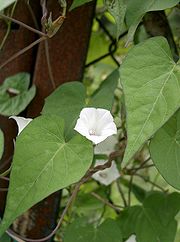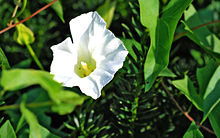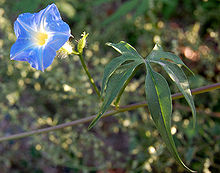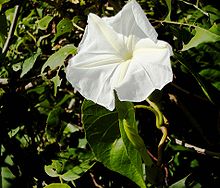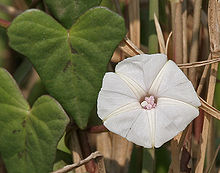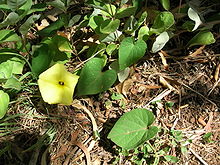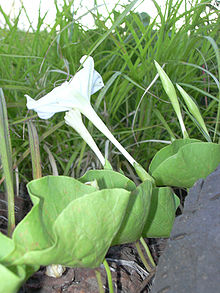- Ipomoea
-
- "Ipomoea" is also an album by the ethereal wave band Love Spirals Downwards, and a short story by John Rackham, published by Ace Books in 1969.
Ipomoea 
Ipomoea carnea, called canudo-de-pita in Brazil Scientific classification Kingdom: Plantae (unranked): Angiosperms (unranked): Eudicots (unranked): Asterids Order: Solanales Family: Convolvulaceae Tribe: Ipomoeeae Genus: Ipomoea
L. 1753[1]Species More than 500, see text
Synonyms Acmostemon Pilg.
Batatas Choisy
Bonanox Raf.
Calonyction Choisy
Calycantherum Klotzsch
Diatremis Raf.
Dimerodisus Gagnep.
Exogonium Choisy
Mina Cerv.
Parasitipomoea Hayata
Pharbitis Choisy
Quamoclit Mill.
Quamoclit Moench[1]Ipomoea (
 /ˌɪpɵˈmiːə/)[2] is the largest genus in the flowering plant family Convolvulaceae, with over 500 species. Most of these are called "morning glories", but this can refer to related genera also. Those formerly separated in Calonyction (Greek καλός, kalos, good and νύκτα, nycta, night) are called "moonflowers". The generic name is derived from the Greek words ιπς (ips) or ιπος (ipos), meaning "worm" or "bindweed," and όμοιος (homoios), meaning "resembling". It refers to their twining habit.[3] The genus occurs throughout the tropical and subtropical regions of the world, and comprises annual and perennial herbaceous plants, lianas, shrubs and small trees; most of the species are twining climbing plants.
/ˌɪpɵˈmiːə/)[2] is the largest genus in the flowering plant family Convolvulaceae, with over 500 species. Most of these are called "morning glories", but this can refer to related genera also. Those formerly separated in Calonyction (Greek καλός, kalos, good and νύκτα, nycta, night) are called "moonflowers". The generic name is derived from the Greek words ιπς (ips) or ιπος (ipos), meaning "worm" or "bindweed," and όμοιος (homoios), meaning "resembling". It refers to their twining habit.[3] The genus occurs throughout the tropical and subtropical regions of the world, and comprises annual and perennial herbaceous plants, lianas, shrubs and small trees; most of the species are twining climbing plants.Contents
Uses and ecology
Human use of Ipomoea is threefold: First, most species have spectacular, colorful flowers and are often grown as ornamental plants, and a number of cultivars have been developed. Their deep flowers attract large Lepidoptera - especially Sphingidae such as the Pink-spotted Hawkmoth (Agrius cingulata) - or even hummingbirds.
Second, the genus includes food crops; the tubers of Sweet Potato (I. batatas) and the leaves of Water Spinach (I. aquatica) are commercially important food items and have been for millennia. The Sweet Potato is one of the Polynesian "canoe plants", transplanted by settlers on islands throughout the Pacific. Water Spinach is used all over eastern Asia and the warmer regions of the Americas as a key component of well-known dishes such as Canh chua rau muống (Mekong sour soup) or Callaloo; its numerous local names attest to its popularity. Other species are used on a smaller scale, e.g. the Whitestar Potato (I. lacunosa) traditionally eaten by some Native Americans like the Chiricahua Apaches, or the Australian Bush Potato (I. costata).
Peonidin, an anthocyanidin potentially useful as a food additive, is present in significant quantities in the flowers of the "Heavenly Blue" cultivars.
Moon Vine (I. alba) sap was used for vulcanization of the latex of Castilla elastica (Panama rubber tree, Nahuatl: olicuáhuitl) to rubber; as it happens, the rubber tree seems well-suited for the vine to twine up upon, and the two species are often found together. As early as 1600 BCE, the Olmecs started to produce the balls used in the Mesoamerican ballgame.[4]
The root called John the Conqueror in hoodoo and used in lucky and/or sexual charms (though apparently not as a component of love potions) usually seems to be from I. jalapa. The testicle-like dried tubers are carried as an amulet and rubbed by the user to gain good luck in gambling or flirting. As Willie Dixon wrote, somewhat tongue-in-cheek, in his song "Rub My Root" (a Muddy Waters version is titled "My John the Conquer Root"):
- My pistol may snap, my mojo is frail
- But I rub my root, my luck will never fail
- When I rub my root, my John the Conquer root
- Aww, you know there ain't nothin' she can do, Lord,
- I rub my John the Conquer root
As medicine and entheogen
 Ergine (D-Lysergic acid amide)
Ergine (D-Lysergic acid amide)
 Ergonovine (ergometrine)
Ergonovine (ergometrine)
The third way humans use Ipomoea is due to these plants' content of medically and psychoactive compounds, mainly alkaloids. Some species are renowned for their properties in folk medicine and herbalism; for example Vera Cruz Jalap (I. jalapa) and Tampico Jalap (I. simulans) are used to produce jalap, a cathartic preparation accelerating the passage of stool. Kiribadu Ala (Giant Potato, I. mauritiana) is one of the many ingredients of chyawanprash, the ancient Ayurvedic tonic called "the elixir of life" for its wide-ranging properties.
Other species were and still are used as a potent entheogen. Seeds of Mexican Morning Glory (tlitliltzin, I. tricolor) were thus used by Aztecs and Zapotecs in shamanistic and priestly divination rituals, and at least by the former also as a poison, to give the victim a "horror trip" (see also Aztec entheogenic complex). Beach Moonflower (I. violacea) was also used thus, and the cultivars called Heavenly Blue Morning Glory, touted today for their psychoactive properties, seem to represent an indeterminable assembly of hybrids of these two species.
Responsible for the entheogenic activity are probably ergoline derivatives (lysergamides). Ergine (LSA), isoergine, D-lysergic acid N-(α-hydroxyethyl)amide and lysergol have been isolated from I. tricolor, I. violacea and/or Purple Morning Glory (I. purpurea), but although these are often assumed to be the cause of the plants' effects, this is not supported by scientific studies which show that although psychoactive these compounds are not notably hallucinogenic.[citation needed] Alexander Shulgin in TiHKAL suggests that ergonovine is responsible instead, having verified psychoactive properties, though it is not unlikely that yet other undiscovered lysergamides are present in the seeds.
Though most often noted as a drug, the lysergamides are also of medical importance. Ergonovine enhances the action of oxytocin, used to still postpartum bleeding. Ergine induces drowsiness and a relaxed state and might be useful in treating anxiety disorder. Whether Ipomoea species are a useful source of these compounds remains to be determined. In any case, in some jurisdictions certain Ipomoea are regulated, e.g. by the Louisiana State Act 159 which bans cultivation of I. violacea except for ornamental purposes.
Pests and diseases
Many herbivores avoid morning glories like Ipomoea, as the high alkaloid content makes these plants unpalatable, if not toxic. Nonetheless, Ipomoea species are used as food plants by the caterpillars of certain Lepidoptera (butterflies and moths); see list of Lepidoptera which feed on Ipomoea. For a selection of diseases of the Sweet Potato (I. batatas), many of which also infect other members of this genus, see List of sweet potato diseases.
Selected species
- Ipomoea abrupta R.Br.
- Ipomoea alba L. – Moon Vine
- Ipomoea alpina Rendle
- Ipomoea amnicola Morong – Red-center Morning Glory
- Ipomoea aquatica Forssk. – Water Spinach, Water Morning Glory, Water Convolvulus, On(g) Choy, wéngcài (China), "Chinese spinach", "swamp cabbage"
- Ipomoea aristolochiaefolia
- Ipomoea asarifolia
- Ipomoea barbatisepala A.Gray
- Ipomoea batatas (L.) Lam. – Sweet Potato, "tuberous morning glory"
- Ipomoea batatoides Benth.
- Ipomoea bona-nox
- Ipomoea cairica – Coast Morning Glory, Cairo Morning Glory, Mile-a-minute Vine, Messina Creeper, Railroad Creeper
- Ipomoea calobra F.Muell.
- Ipomoea capillacea (Kunth) G.Don
- Ipomoea carnea – Pink Morning Glory, canudo-de-pita (Brazil)
- Ipomoea coccinea – Red Morning Glory, Redstar, "Mexican Morning Glory"
- Ipomoea cordatotriloba L. – Little Violet Morning Glory
- Ipomoea cordatotriloba var. torreyana – Purple Bindweed
- Ipomoea cordifolia Carey ex Voight – Heart-leaved Morning Glory
- Ipomoea costata – Rock Morning Glory, Bush Potato
- Ipomoea costellata Torr. – Crest-ribbed Morning Glory
- Ipomoea cristulata Hallier f. – Trans-Pecos Morning Glory
- Ipomoea cynanchifolia (Meisn.) Mart.
- Ipomoea daturaefolia Meisn.
- Ipomoea demerariana Choisy (= I. phyllomega)
- Ipomoea diversifolia R.Br.
- Ipomoea dumetorum Willd. ex Roemer & J.A.Schultes – Railwaycreeper
- Ipomoea eggersiana Peter
- Ipomoea eggersii (House) D.Austin – Egger's Morning Glory
- Ipomoea eriocarpa R.Br.
- Ipomoea ghika
- Ipomoea gracilis R.Br.
- Ipomoea graminea R.Br.
- Ipomoea halierca
- Ipomoea hederacea – Ivy-leaved Morning Glory
- Ipomoea hederifolia – Scarlet Morning Glory, Scarlet Creeper, Star Ipomoea, trompillo (= I. coccinea Sessé & Moc.)
- Ipomoea horrida Huber
- Ipomoea horsfalliae – Lady Doorly's Morning Glory, Cardinal Creeper, Prince Kuhio Vine
- Ipomoea imperati (Vahl) Griseb.[5]
- Ipomoea incisa R.Br.
- Ipomoea indica – Oceanblue Morning Glory, Blue Morning Glory, Blue Dawn Flower, koali awa (Hawaii)
- Ipomoea jalapa (L.) Pursh.
- Ipomoea krugii Urban – Krug's White Morning Glory
- Ipomoea lacunosa L. – Whitestar Potato, Whitestar
- Ipomoea leptophylla – Bush Morning Glory, Bush Moonflower, "manroot"
- Ipomoea leucantha[verification needed] Jacq. (non Webb ex Hook., Desv. ex Ham.)
- Ipomoea lindheimeri Gray – Lindheimer's Morning Glory
- Ipomoea littoralis Blume – White-flowered Beach Morning Glory
- Ipomoea lobata (Cerv.) Thell. – Fire Vine, "Spanish Flag"
- Ipomoea longifolia Benth. – Pink-throated Morning Glory
- Ipomoea macrantha
- Ipomoea macrorhiza Michx. – Large-rooted Morning Glory
- Ipomoea marginata (Desr.) Verdc.
- Ipomoea mauritiana Jacq. – Giant Potato, Kiribadu Ala[verification needed], likam (Hawaii)
- Ipomoea meyeri (Spreng.) G.Don – Meyer's Morning Glory
- Ipomoea microdactyla Griseb. – Calcareous Morning Glory
- Ipomoea × multifida – "Cardinal Climber" (I. coccinea × I. quamoclit)
- Ipomoea nil – White-edged Morning Glory, Ivy Morning Glory, Japanese Morning Glory
- Ipomoea obscura – Obscure Morning Glory, Small White Morning Glory
- Ipomoea ochracea (Lindl.) G.Don – Fence Morning Glory
- Ipomoea oenotherae Hallier f.
- Ipomoea pandurata – Wild Potato Vine, Big-rooted Morning Glory, Man-of-the-Earth, "manroot"
- Ipomoea pes-caprae (L.) R.Br. – Beach Morning Glory, "goat's foot"
- Ipomoea pes-caprae ssp. brasiliensis – salsa-da-praia (Brazil)
- Ipomoea plebeia R.Br.
- Ipomoea plummerae Gray – Huachuca Mountain Morning Glory
- Ipomoea polymorpha Roem. & Schult. (= I. heterophylla R.Br.)
- Ipomoea pubescens Lam. – Silky Morning Glory (= I. heterophylla Ortega)
- Ipomoea pulcherrima
- Ipomoea purga (Wender.) Hayne – Vera Cruz Jalap (= I. jalapa auct. non L.)
- Ipomoea purpurea – Common Morning Glory, Purple Morning Glory, Tall Morning Glory
- Ipomoea quamoclit – Cypress Vine, Cypressvine Morning Glory, Cardinal Creeper, Cardinal Vine, Star Glory, "hummingbird vine"
- Ipomoea racemigera F.Muell. & Tate
- Ipomoea repanda Jacq. – Bejuco Colorado
- Ipomoea repens
- Ipomoea rubens Choisy (= I. fragans)
- Ipomoea rupicola House – Cliff Morning Glory
- Ipomoea sagittata Poir. – Saltmarsh Morning Glory
- Ipomoea setifera Poir. – bejuco de Puerco
- Ipomoea setosa Ker Gawl. – Brazilian Morning Glory
- Ipomoea shumardiana (Torr.) Shinners – Narrow-leaved Morning Glory
- Ipomoea simulans – Tampico Jalap, purga de Sierra Gorda
- Ipomoea sloteri – "Cardinal Climber"
- Ipomoea steudelii Millsp. – Steudel's Morning Glory
- Ipomoea stolonifera
- Ipomoea temascaltepecensis Wilkin[6]
- Ipomoea tenuiloba Torr. – Spiderleaf
- Ipomoea tenuirostris[7]
- Ipomoea tenuissima Choisy – Rockland Morning Glory
- Ipomoea ternifolia Cav. – Triple-leaved Morning Glory
- Ipomoea thurberi Gray – Thurber's Morning Glory
- Ipomoea tricolor Cav. – Mexican Morning Glory, tlitliltzin (Nahuatl), badoh negro
- Ipomoea triloba – Littlebell, Aiea Morning Glory
- Ipomoea tuberculata
- Ipomoea tuberosa L. – Hawaiian Woodrose
- Ipomoea tuboides O.Deg. & van Ooststr. – Hawaii Morning Glory
- Ipomoea turbinata Lag. – Lilacbell
- Ipomoea velutina R.Br.
- Ipomoea violacea L. – Beach Moonflower, Sea Moonflower
- Ipomoea wrightii – Wright's Morning Glory
Formerly placed here
- Ellisia nyctelea (L.) L. (as I. nyctelea L.)
- Jacquemontia ovalifolia (as I. ovalifolia Choisy)
- Jacquemontia tamnifolia (L.) Griseb. (as I. tamnifolia L.)
- Merremia aegyptia (L.) Urb. (as I. aegyptia L.)
- Merremia cissoides (Lam.) Hallier f. (as I. cissoides (Lam.) Griseb.)
- Merremia discoidesperma (Donn. Sm.) O'Donell (as I. discoidesperma Donn. Sm.)
- Merremia dissecta (Jacq.) Hallier f. (as I. dissecta (Jacq.) Pursh or I. sinuata Ortega)
- Merremia emarginata (Burm. f.) Hallier f. (as I. reniformis (Roxb.) Sweet)
- Merremia kingii (Prain) Kerr (as I. kingii Prain)
- Merremia mammosa (Lour.) Hallier f. (as I. mammosa (Lour.) Choisy)
- Merremia peltata (L.) Merr. (as I. nymphaeifolia Blume)
- Merremia pterygocaulos (Choisy) Hallier f. (as I. pterygocaulos Choisy)
- Merremia quinquefolia (L.) Hallier f. (as I. quinquefolia L.)
- Merremia sibirica (L.) Hallier f. (as I. sibirica (L.) Pers.)
- Merremia tuberosa (L.) Rendle (as I. tuberosa L.)
- Merremia umbellata (L.) Hallierf. (as I. polyanthes Roem. & Schult. or I. pterodes Choisy)
- Operculina aequisepala (Domin) R.W.Johnson (as I. aequisepala Domin)
- Operculina hamiltonii (G.Don) D.F.Austin & Staples (I. hamiltonii G.Don)
- Operculina turpethum (L.) Silva Manso (as I. turpethum (L.) R.Br.)
- Piper kadsura (Choisy) Ohwi (as I. kadsura Choisy)
- Stictocardia macalusoi (Mattei) Verdc. (as I. macalusoi Mattei)
- Stictocardia tiliifolia (Desr.) Hallier f. (as I. campanulata L.)
- Turbina corymbosa (L.) Raf. (as I. burmannii Choisy)
- Xenostegia medium (L.) D.F.Austin & Staples (as I. medium (L.) Druce)
- Xenostegia tridentata (L.) D.F.Austin & Staples (as I. angustifolia Jacq.)[5]
See also
 Vera Cruz Jalap (I. purga) from Köhler's Medicinal Plants
Vera Cruz Jalap (I. purga) from Köhler's Medicinal Plants
 Lilacbell (I. turbinata) in Hyderabad, India
Lilacbell (I. turbinata) in Hyderabad, India
Footnotes
- ^ a b "Genus: Ipomoea L.". Germplasm Resources Information Network. United States Department of Agriculture. 2007-10-05. http://www.ars-grin.gov/cgi-bin/npgs/html/genus.pl?6064. Retrieved 2010-11-10.
- ^ Sunset Western Garden Book, 1995:606–607
- ^ Austin, Daniel F. (2004). Florida Ethnobotany. CRC Press. p. 365. ISBN 9780849323324. http://books.google.com/books?id=eS7lX_rC3GEC&.
- ^ Massachusetts Institute of Technology Summer Institute in Materials Science and Material Culture: Rubber Processing in Ancient Mesoamerica. Retrieved 2007-NOV-22.
- ^ a b "GRIN Species Records of Ipomoea". Germplasm Resources Information Network. United States Department of Agriculture. http://www.ars-grin.gov/cgi-bin/npgs/html/splist.pl?6064. Retrieved 2010-11-10.
- ^ Wilkin, Paul (1995). "A New Species of Ipomoea (Convolvulaceae) from Mexico State, Mexico, and Its Evolution". Kew Bulletin (Netherlands: Springer) 50 (1): 93–102. ISSN 1874-933X. JSTOR 4114611.
- ^ Bussmann, R. W., et al. (2006). Plant use of the Maasai of Sekenani Valley, Maasai Mara, Kenya. J Ethnobiol Ethnomed 2 22.
Sources
Categories:- Ipomoea
- Invasive plant species in South Africa
Wikimedia Foundation. 2010.

